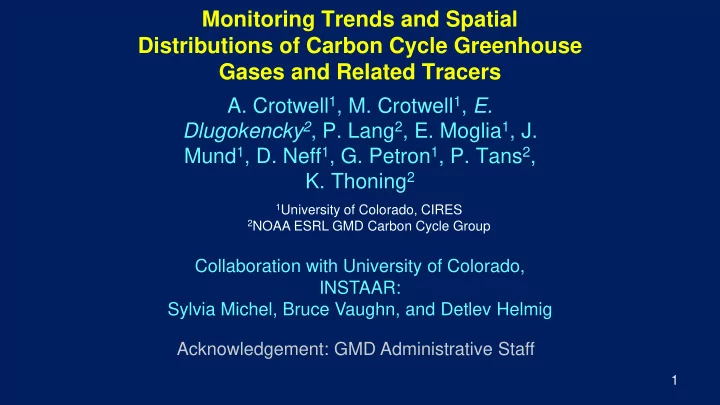

Monitoring Trends and Spatial Distributions of Carbon Cycle Greenhouse Gases and Related Tracers A. Crotwell 1 , M. Crotwell 1 , E. Dlugokencky 2 , P. Lang 2 , E. Moglia 1 , J. Mund 1 , D. Neff 1 , G. Petron 1 , P. Tans 2 , K. Thoning 2 1 University of Colorado, CIRES 2 NOAA ESRL GMD Carbon Cycle Group Collaboration with University of Colorado, INSTAAR: Sylvia Michel, Bruce Vaughn, and Detlev Helmig Acknowledgement: GMD Administrative Staff 1
View recent data: www.esrl.noaa.gov/gmd/dv/iadv/ Cooperative Global Air Sampling Network - unique in its coverage Weekly samples collected with portable sampler Sites selected to sample well-mixed air 2
Scientific Motivation • Determine budgets and how they change with time – Quantify emissions and sinks of LLGHGs at global to large regional spatial scales – Determine impacts of climate change on LLGHG budgets • Long-term continuity and consistency of observations are important Approach • Accurately, precisely measure spatial, temporal distributions of LLGHGs and related tracers – Meaningful temporal and spatial gradients – Ensure long-term consistency with QA scheme • Developed by Dave Keeling in 1950s 3
Analytical Capabilities (All flask-air samples) Gas Uncertainty (68% CI) Technique 0.08 μmol mol -1 NDIR → CRDS CO 2 GC/FID → CRDS 0.9 nmol mol -1 CH 4 VUV- RF → TILDAS 1.7 nmol mol -1 CO *0.5 nmol mol -1 H 2 GC/PD-HeID GC/ECD → TILDAS 0.26 nmol mol -1 N 2 O 0.04 pmol mol -1 SF 6 GC/ECD δ 13 CO 2 *0.01‰ DI-IRMS δ 13 CH 4 *0.04‰ GC/CF-IRMS † <15% C 2 -C 7 NMHC GC/FID 4 *Repeatability; † Median pair difference
>50 years 5
Latitude gradient constrains budgets of emissions and sinks: Tans et al., 1990: NH terrestrial carbon sink Fung et al., 1991: Less HNH, greater tropical CH 4 emissions 6
SF 6 : Test Model Transport 7 Peters et al., JGR, 2004; Basu et al., ACP, 2016.
Calculation of global and zonal surface means: NOAA global trends web pages (Organizations, e.g., 2º Institute) Assessments (e.g., IPCC) AGGI (Radiative forcing) Peer-reviewed global GHG budget analyses 8
~45% of FF 9 Based on update of Ballantyne et al., Nature, 2012.
δ 13 C as process indicator: CO 2 - Differentiate ocean/terrestrial biosphere fluxes -Biosphere: ~0.045‰ ppm -1 -Ocean: ~0.005‰ ppm -1 δ 13 C scaled to match CO 2 residuals: δ 13 C 10
Use of observations in atm inversion products to study global budgets: CT (CO 2 and CH 4 ) CAMS (CO 2 , CH 4 , and N 2 O) GCP (CO 2 and CH 4 ) Research studies Also used in regional-scale studies: Bergamaschi et al., 2018 11
Summary • CCG network is unique in its spatial coverage • Continually evolving to meet scientific needs • Delivers internally-consistent, calibrated observations of known quality over long time scales – Detailed QA/QC system • Great scientific benefit at relatively small cost – Fundamental constraints on GHG budgets and CTMs 12
Uncertainties • Uncertainties on measurements from flask-air – Assessing major components of uncertainty ( u i ) – Other terms, when required – u 2 = u st 2 + u lt 2 + u sp 2 + …. • Uncertainties on zonal means – Network contribution (bootstrap - random sampling) – Potential bias contribution (Monte Carlo – random modifications) 13
Future of Network • Enhance spatial coverage – Increase sampling from ships (restart POC; add new basins) – Add tropical sites (Taiping Is.; Reunion Is.) – Improve existing sampling methods • Improve quality of measurements – Testing new flask-air analysis system • Increase efficiency (w/o sacrificing quality) 14
Analysis Upgrade: Same time/sample Less Sample Used Improved Precision Standard Cal Scheme Improved User Interface Increased Efficiency 15
Ensuring Quality of Data • Quality Assurance – Daily test flasks and surveillance cylinders – Testing portable air samplers • Quality Control – Inspection of “data” for sampling and analysis problems – Comparisons with independent measurements 16
QA/QC • Test flasks – Pair filled from cylinder of calibrated air run daily • Target cylinders – Short-term (close to ambient) run monthly – Long-term (wide range in X) run few times/year • Flask/in situ comparisons at observatories • Comparisons with GAW partners + others – Same air – Co-located 17
Remote Sensing • Never calibrated, only evaluated – e.g., with vertical profiles; Aircore • Sensor degradation over time • Potential biases (e.g., land vs ocean) • “Short” deployment for satellites • Retrieve total column; strongest signals at surface • Different retrieval versions give very different results – e.g., in CO 2 inversions 18
CO 2 CH 4 19
Calibration: Calibration links the measured response of an analyzer, under controlled conditions, to known values of measurement standards (with known uncertainties). That response is used to assign values and uncertainties to other samples. Standards must be linked to fundamental SI units in a single, unbroken, hierarchical chain of traceability. 20
21
22
Indicator of changing Arctic CH 4 emissions Updated from: Dlugokencky et al., Geophys. Res. Lett., 30 (19), 23 1992, doi:10.1029/2003GL018126, 2003.
Hirsch et al., GBC, 2006: Redistributed emissions, doubling those from N tropics Use SF 6 to: -show emissions reported to UNFCCC are too small -test transport in ATM 24
25 Alert, Canada
Quality Control 26
Using in situ measurements for CO 2 quality assurance: SPO Δ CO 2 (ppm) Year 27
28
-Added CO 2 at obs. in early-1970s -Expansion through 1980s -Increasing # species measured -Addition of N.A. focus (PFPs) -Measurement load increased with expansion of network and addition of NA projects 29
30
A Dynamic Program • 1967 – began CO 2 measurements • 1983 – began CH 4 measurements • 1988 – began CO/H 2 measurements • 1990 – began δ 13 CO 2 measurements • 1997 – began N 2 O/SF 6 measurements • 1998 – began δ 13 CH 4 measurements • 2004 – began halo-compound measurements • 2005 – began NMHC measurements 31
Recommend
More recommend